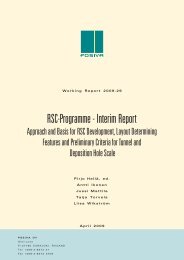Bentonite Mineralogy Part 1: Methods of Investigation - Posiva
Bentonite Mineralogy Part 1: Methods of Investigation - Posiva
Bentonite Mineralogy Part 1: Methods of Investigation - Posiva
You also want an ePaper? Increase the reach of your titles
YUMPU automatically turns print PDFs into web optimized ePapers that Google loves.
34<br />
(ultramicrotome). This part <strong>of</strong> the work was not finished in time and the results will be<br />
reported later.<br />
6.4 Exchangeable cations & cation exchange capacity (CEC)<br />
Five methods were used for the determination <strong>of</strong> exchangeable cations. All samples<br />
were leached with 0,1 M BaCh (sample to solution ratio 1 :50) and 1 M NH4-acetate, pH<br />
7 (sample to solution ratio 1 :50). The samples were gently crushed and sieved to pass 2<br />
mm before leaching and dried at 40°C in a forced air oven. The N a, K, Ca and Mg<br />
concentrations in the extracts were determined using inductively coupled plasma atomic<br />
emission spectrometer (ICP-AES) at the Geolaboratory <strong>of</strong> the Geological Survey <strong>of</strong><br />
Finland, Kuopio. The CEC was calculated as sum <strong>of</strong> exchangeable elements and given<br />
as cmol+/kg (centimoles <strong>of</strong> charge per kilogram <strong>of</strong> material, which corresponds to the<br />
also commonly used CEC meq/1 00 g). pH <strong>of</strong> the samples was determined<br />
potentiometrically in the BaCh extract.<br />
The Cu-method was tested with four samples (MX-80, Kutch 8937, Milos H and<br />
Friedland) at the Department <strong>of</strong> Geology, University <strong>of</strong> Helsinki by Dr.Phil. Antti<br />
Vuorinen. A 0,05 M Cu(II) ethylenediamine solution was prepared (Bergaya & Vayer,<br />
1997) and its pH adjusted to pH 4 and pH 7 with HCl and NH40H. The sample to<br />
solution ratio was 500 mg/30 ml. The suspensions were gently shaken for 22 hours and<br />
centrifuged for 20 min at 4 000 r/min. Final pH ranged from 4,4 to 5,1 (pH 4) and from<br />
6,4 to 7,1 (pH 7). The elemental concentrations were measured with ICP-AES.<br />
Exchangeable cations and CEC <strong>of</strong> the same four samples was determined also by<br />
leaching with 0,1 and 0,01 M CsCl as well as with 1 M LiCl. Initial pH <strong>of</strong> the CsCl<br />
solutions was 5,86 (0,1M) and 5,23 (0,01M). pH <strong>of</strong> the LiCl solution was adjusted to<br />
7,0. The sample to solution ratio in all experiments was 500 mg/30 ml. The suspensions<br />
were gently shaken for 22 hours and centrifuged for 20 min at 4 000 r/min. Final pH<br />
ranged from 8,4 to 9,5 (Cs 0,1M), from 8,5 to 9,6 (Cs 0,01) and from 7,3 to 7,7 (Li).<br />
The elemental concentrations were determined as above.<br />
6.5 Total chemical analysis<br />
For the total chemical analysis, all samples were pulverized in a tempered carbide-steel<br />
grinding vessel and dried at 40°C in a forced air oven. Pressed powder pellets were<br />
prepared and the elemental composition determined using X-ray fluoresence<br />
spectroscopy (XRF) at the Geolaboratory <strong>of</strong> the Geological Survey <strong>of</strong> Finland, Espoo.<br />
Total sulphur was determined with a S-analyzer and total carbon with a C-analyzer<br />
using a combustion technique. Carbonate carbon and non-carbonate carbon were<br />
determined with a C-analyzer using a combustion technique and treatment with HCl.<br />
The method validation has not yet been completed and therefore the results are<br />
preliminary. H20- was determined gravimetrically by heating the samples to 1 05°C.<br />
Detection limits are given in tables 6-2 and 6-3.

















